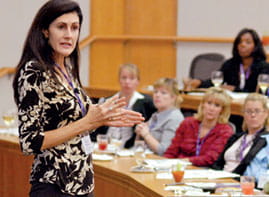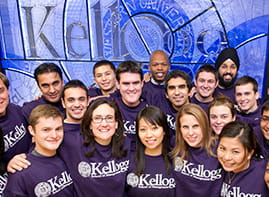Kellogg’s Entrepreneur-in-Residence program pairs MBA students with high-profile entrepreneurs for one-on-one networking sessions
7/3/2012 - Imagine being a budding entrepreneur and being able to talk with the innovators of some of the greatest new businesses of our time. Thanks to Kellogg’s
Entrepreneur-in-Residence program, MBA students are able to do just that.
Since 2005, Kellogg students have had the opportunity to meet one-on-one with high-profile entrepreneurs through this interactive program, coordinated by the Larry and Carol Levy Institute for Entrepreneurial Practice.
“We don’t call it networking as much as we call it apprenticeship,” explains Scott Whitaker, associate director of the Levy Center and founder of the program. “It’s a moment with someone who’s mastered the art of entrepreneurship.”
The 30-minute rule
Visiting entrepreneurs are set up in an “executive suite,” which is equipped with everything from bottles of water to pens and paper. Students sign up for appointments in 30-minute intervals, with some students opting for a working lunch session.
“The students cannot ask for a job and they can’t ask for investment money,” Whitaker explains, adding that students are asked to submit five key questions in advance of the face-to-face meetings. “The entrepreneur in residence can offer a job or investment capital, but it’s rare.”
The program can accommodate anywhere from 14 to 17 students and Whitaker says it always fills up. And while every student has a different goal and mission, they all have essentially the same question: What does it take to make the leap of faith?
“It’s not really a leap, but it’s a metaphor for what it takes to quit a job and start the venture,” Whitaker says.
The answer is always the same: Don’t quit and start. Start the new business first. If it succeeds, then quit. But don’t quit your day job until your dream is up and running.
Balancing the risk David Chookaszian, a Kellogg student who had the opportunity to meet with 2004 alum and co-founder of crowdSPRING.com Mike Samson in February, says a deeper understanding of the risk factor was one of the most valuable things he gained from the program.
“The most interesting thing to me personally is, how do you balance having a family and needing some sort of steady income with taking the risk to do something you’re really passionate about?” he says.
That 30-minute meeting with Samson is what helped Chookaszian make an important decision about his summer plans. Before, he was planning to devote all of his energy to working on his new business idea. Now he’s decided to take on a summer internship and work on the business “on the side.”
So while he has passion for his idea, he’s also finding balance — two ingredients visiting entrepreneurs say are key to finding success.
Paying it forward
Samson, who launched the crowdSPRING online marketplace for creative services with co-founder Ross Kimbarovsky in May 2008, says he is happy to be a part of the Entrepreneur in Residence program because he likes to be able to pay it forward.
“My attitude has always been that when I was starting out and building my company, there were a lot of people who were generous with their time,” he says. “I’ve been doing it for about two to three years now and I really enjoy it. I really love sitting and talking with students about their ideas and their businesses.”
Valuable feedback Kellogg student Alfredo Garcia says the program offers something very powerful to hopeful young entrepreneurs — validation.
“Getting your concept validated by an entrepreneur, someone who’s been in the trenches, is one of the single most valuable things.”
More so than other students or even professors, Garcia says the Entrepreneurs in Residence can offer common sense advice about what makes sense and what doesn’t.
Whitaker says sometimes the most obvious answer to many of the students’ questions is in front of them. “Look in the mirror,” he explains. “You are the leader and you’ve got it.”
The ultimate compliment Whitaker is proud of the Entrepreneur in Residence program and says it’s one of the best features of the Kellogg MBA program.
His favorite anecdote and a sign of its success is the story of a student who left one of the 30-minute sessions and told him: “It was one of the most refreshing conversations I’ve had at Kellogg. He told me I don’t know anything yet. I really appreciated being told that.”






